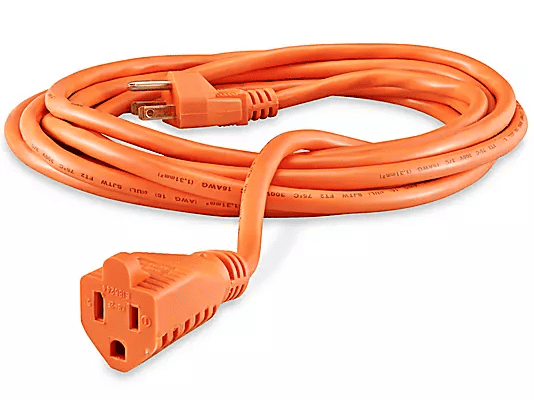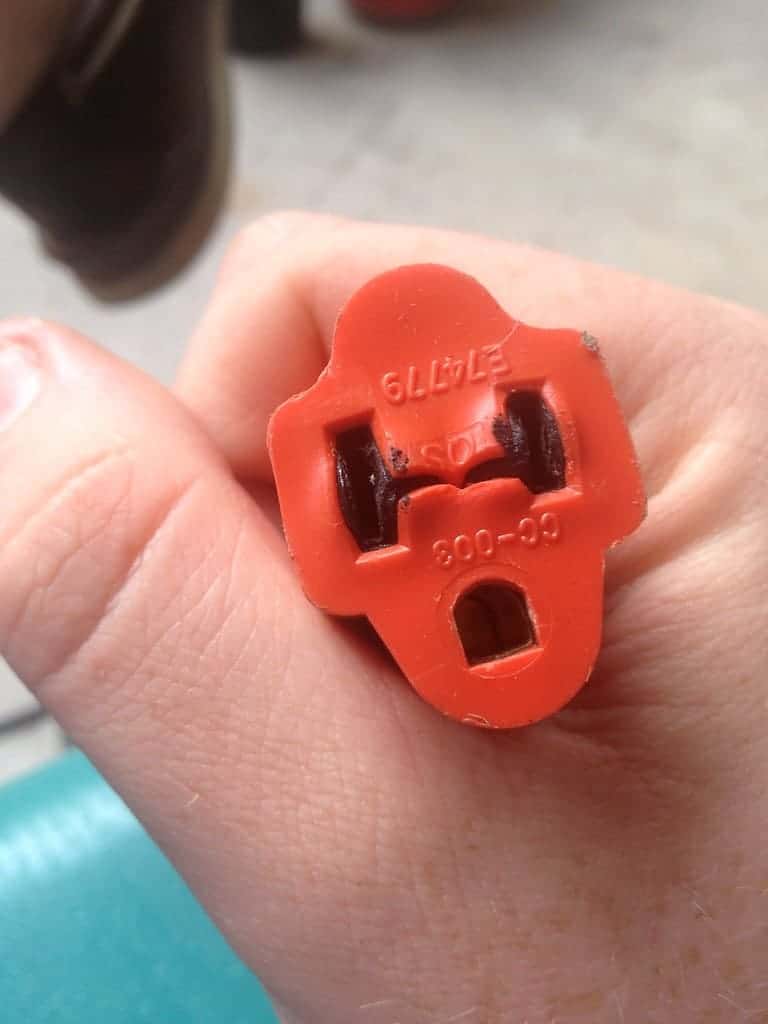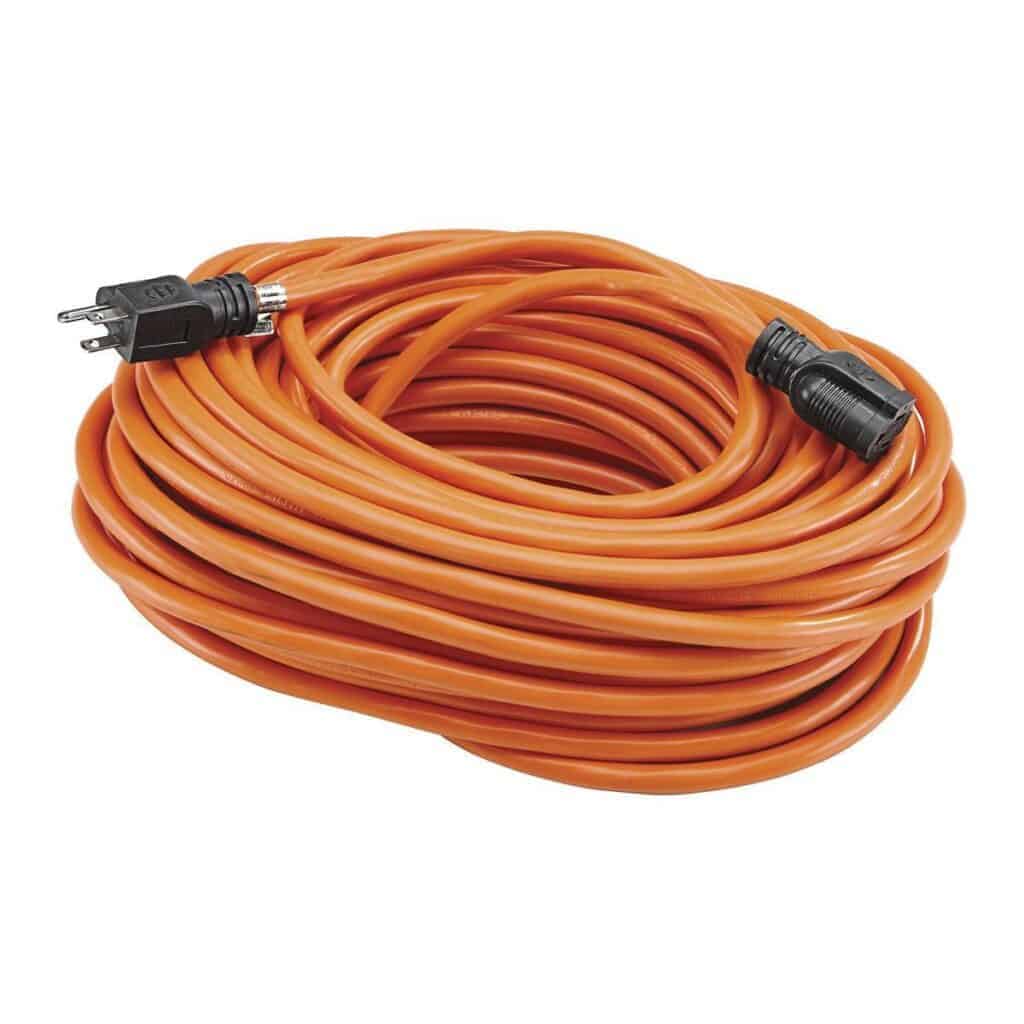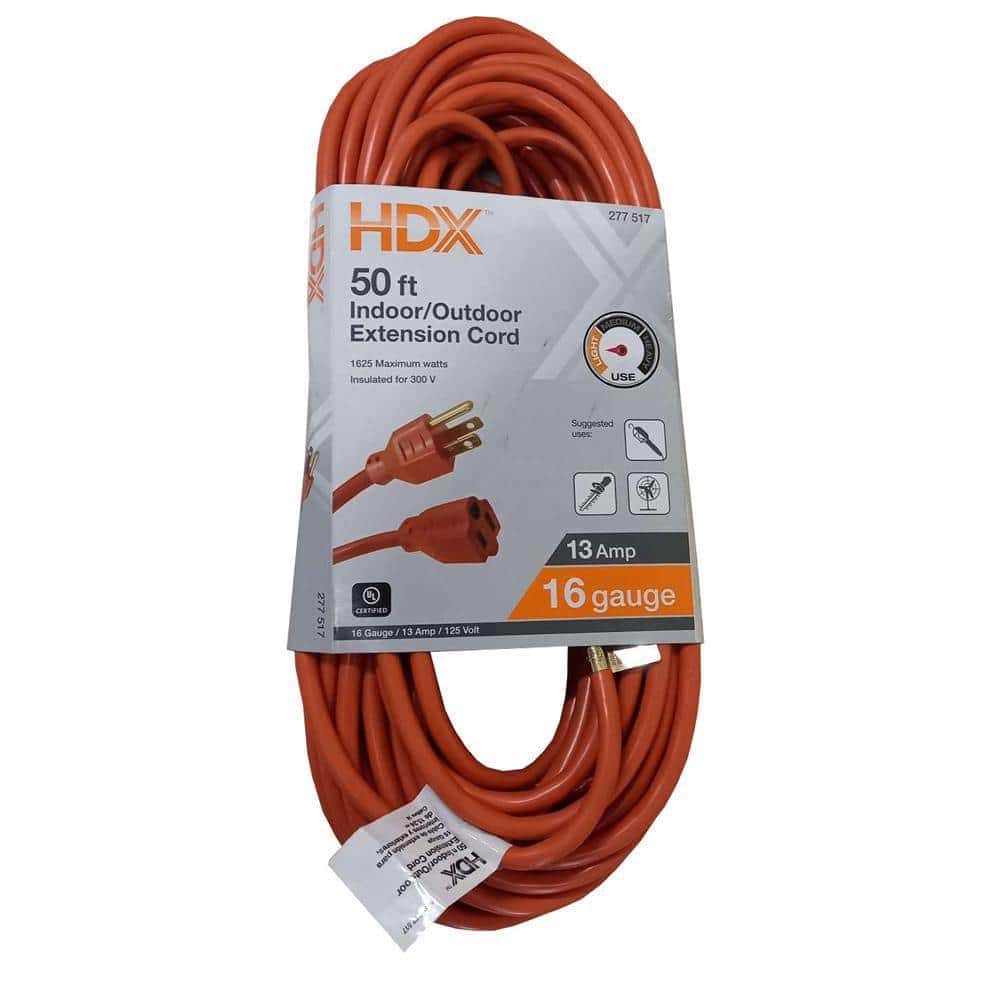Understanding extension cord gauges and colors is important for using electricity safely and effectively. The gauge refers to the thickness of the wire inside the cord, while the color often indicates its intended use. Extension cords come in various types designed for specific situations. For example, cords labeled “SJTW” are suitable for outdoor use due to their weather-resistant jackets. Cords marked “SJT” are generally used indoors, while “SJOW” cords are ideal for heavy-duty tasks and can withstand exposure to oils and solvents. When choosing an extension cord, consider where and how you’ll use it to select the right type.
Extension Cords, Safety, and Selection

Extension Cord Gauges
The gauge of an extension cord determines its capacity to carry electrical current. Lower gauge numbers indicate thicker wires that can handle more power. Common gauges include:
| Gauge | Typical Usage | Maximum Amps |
|---|---|---|
| 18 | Light duty (lamps, electronics) | 5-7 |
| 16 | Medium duty (small appliances) | 10-13 |
| 14 | Heavy duty (power tools, space heaters) | 15 |
| 12 | Extra heavy duty (large appliances, air conditioners) | 20 |
Using a cord with a gauge too small for the appliance can lead to overheating and potential fire hazards.
Extension Cord Colors
While not standardized, extension cord colors often provide clues about their intended environment:
- White/Light Colors: Typically used indoors, where they blend with surroundings.
- Orange: Usually designated for heavy-duty use or outdoor applications.
- Yellow: Sometimes used for indoor/outdoor cords or for high-visibility purposes.
- Green: Occasionally used for outdoor cords or to signify grounding.
However, color alone isn’t a reliable indicator. Always check the cord’s label for specific ratings and usage guidelines.
Safety Considerations
- Length: Longer cords have more resistance, so use the shortest cord possible for the job.
- Condition: Inspect cords for damage before each use. Discard any with fraying, cuts, or exposed wires.
- Overloading: Never exceed the cord’s rated amperage.
- Water: Keep cords away from water unless they’re specifically rated for wet conditions.
- Storage: Store cords neatly to prevent tangling and damage.
Understanding Amperage and Gauge
The “gauge” of a cord tells you how thick the wires inside are. A lower gauge number means thicker wires that can handle more power. Here’s a simple guide:
- 18 gauge: Ideal for small electronics like lamps, phone chargers, and clocks. These cords can handle up to 5 amps.
- 16 gauge: Suitable for medium-duty appliances such as blenders, small power tools, and TVs. They can carry up to 13 amps.
- 14 gauge: A good choice for larger appliances like space heaters, refrigerators, and most power tools. These cords can handle up to 15 amps.
- 12 gauge: Best for heavy-duty applications, such as large power tools, air conditioners, and some welding equipment. They can carry up to 20 amps.
Always choose a cord with a gauge that matches or exceeds the power needs of your device. This prevents overheating and potential fire hazards.
GFCI Protection: Essential for Safety
Ground Fault Circuit Interrupters (GFCIs) are vital safety devices that protect you from electrical shocks, especially in wet locations. They work by quickly shutting off the power if they sense an imbalance in the electrical current. Consider using extension cords with built-in GFCIs or plugging your cord into a GFCI outlet when using power tools outdoors, in bathrooms, or near water sources.
Voltage Drop: Keeping Power Consistent
Voltage drop is the decrease in voltage that happens as electricity travels along an extension cord. Longer cords have more resistance, which leads to a greater voltage drop. This can cause appliances to run inefficiently or even get damaged. To minimize voltage drop:
- Use the shortest cord possible for the job.
- Choose a thicker cord (lower gauge) for longer distances.
- Avoid using multiple extension cords connected together.
Table: Cord Length and Gauge Recommendations
| Cord Length | Suggested Gauge (up to 10 amps) | Suggested Gauge (over 10 amps) |
|---|---|---|
| Up to 25 feet | 16 AWG | 14 AWG |
| 25 – 50 feet | 14 AWG | 12 AWG |
| Over 50 feet | 12 AWG | 10 AWG or lower |
Cord Reels: Use Them Wisely
Extension cord reels are convenient for storage and transport. However, it’s crucial to always fully unwind the cord before use. When a cord remains coiled on the reel, it can overheat and become a fire hazard. This is because the coiled cord traps heat, preventing it from dissipating properly.
Extension Cord Gauges and Colors
By understanding extension cord gauges and colors, and following basic safety practices, you can ensure safe and efficient electrical power for your tools and appliances.
| Gauge (AWG) | Color | Amp Rating | Maximum Length (ft) | Typical Uses |
|---|---|---|---|---|
| 18 | Green, Yellow | 13 Amps | 25 | Light-duty appliances (lamps, radios) |
| 16 | Orange, Yellow | 16 Amps | 50 | Medium-duty appliances (fans, drills) |
| 14 | Yellow, Green | 15 Amps | 100 | Heavy-duty appliances (power tools, air conditioners) |
| 12 | Yellow, Orange | 20 Amps | 100 | Extra heavy-duty appliances (welding equipment, generators) |
Always check the label for the actual gauge and amp rating.
Notes:
- The maximum lengths listed are for reference only and may vary depending on the specific cord and the amperage draw of the device being used.
- It is always best to choose an extension cord with a gauge that is rated for more amps than the device you will be using. This will help to prevent the cord from overheating and posing a fire hazard.
Understanding Extension Cord Basics
Extension cords are essential tools that allow us to bring power to where it’s needed. From powering a laptop a little further away from the outlet to running a lawnmower in the backyard, they make electricity portable and convenient.
Purpose and Types of Extension Cords
Extension cords do far more than just extend the length of your power source. They come in various types to suit different needs. Indoor extension cords are typically lighter and meant for less demanding tasks like plugging in a table lamp or charging a phone. On the other hand, outdoor extension cords are built tougher to withstand the elements, featuring thicker casings and often a weather-resistant design.
- For Indoor Use: Designed with lighter materials, not suited for high power loads or harsh conditions.
- For Outdoor Use: Heavier and more robust to handle moisture, temperature changes, and more electrical demand.
| Type | Suitability | Typical Characteristics |
|---|---|---|
| Indoor | Inside the home | Lighter, flexible |
| Outdoor | Gardens, workshops | Durable, weatherproof |
It’s also essential to choose the right extension cord for the job, which means understanding the power requirements of your devices to ensure safe operation.
Extension Cord Safety Guidelines
Safety is paramount when it comes to using extension cords. A crucial aspect of this is ensuring that each extension cord is certified by an independent testing laboratory, such as UL (Underwriters Laboratories), affirming that the cord meets specific safety standards.
When using extension cords:
- Check for UL Certification: UL-certified cords have been tested for safe use.
- Inspect Before Use: Look for damage like exposed wires or a loose plug before plugging in.
- Avoid Overloading: Connect only the number of devices the cord is rated to handle.
Follow these guidelines to keep your home and loved ones safe:
- Never Overload: This can cause overheating and pose a fire hazard.
- Do Not Daisy-Chain: Connecting multiple cords can lead to voltage drops and overheating.
- Proper Storage: Unplug, coil without kinks, and store cords to prevent damage.
- Amp and Gauge: Match the cord’s gauge (thickness of wires inside) and amp capacity to the power needs of your device to prevent overheating.

Extension Cord: Troubleshooting Guide
Extension cords are a handy tool for extending the reach of an outlet, but they can sometimes malfunction. If your extension cord isn’t working properly, don’t worry! This troubleshooting guide will help you identify the problem and get your cord back in working order.
| Problem | Possible Cause | Solution |
|---|---|---|
| No power | – Faulty outlet – Damaged plug – Broken wire inside the cord | – Test the outlet with another appliance. – Check the plug for visible damage, such as loose prongs or cracks. – If the cord is visibly damaged, do not use it and replace it immediately. – You can use a multimeter to test for continuity in the cord. If there is no continuity, the cord is broken and needs to be replaced. |
| Sparks or flickering lights | – Loose connection – Overloaded cord | – Make sure the plug is snugly plugged into the outlet and the receptacle. – Check if the cord is plugged into a power strip or surge protector that is overloaded. Unplug some appliances if necessary. – The cord may be the wrong gauge for the appliance you are using. Use a heavier gauge cord for high-wattage appliances. |
| Burning smell | – Overloaded cord – Damaged cord | – Unplug the cord immediately and stop using it. – The cord may be the wrong gauge for the appliance you are using. Use a heavier gauge cord for high-wattage appliances. – If the cord is visibly damaged, do not use it and replace it immediately. |
| Tripped circuit breaker | – Overloaded circuit – Short circuit in the cord | – Unplug all appliances from the circuit and reset the breaker. – If the breaker trips again, there may be a short circuit in the cord. Do not use the cord and have it replaced by a qualified electrician. |
Additional tips:
- Do not use extension cords outdoors unless they are specifically rated for outdoor use.
- Do not run extension cords under carpets or rugs.
- Do not coil extension cords when they are in use.
- Inspect your extension cords regularly for damage and replace them if necessary.
Choosing the Right Gauge and Length
Selecting the appropriate gauge and length for an extension cord is crucial for maintaining safety and ensuring optimal performance of your electrical devices.
Gauge Selection for Different Power Requirements
The thickness of the extension cord is referred to as the gauge, and it’s denoted by the term “AWG” for American Wire Gauge. The rule here is simple: the lower the AWG number, the thicker the wire and the higher its capacity to carry power. For higher-powered appliances, a lower gauge cord is essential to safely transport the required current.
- For devices under 5 amps, such as lamps or clocks, a 16-gauge cord usually suffices.
- Tools or equipment running between 5 and 10 amps, like some power drills, typically require a 14-gauge.
- Large appliances or heavy-duty tools drawing upwards of 10 amps demand at least a 12-gauge extension cord.
Length vs. Power: Understanding Voltage Drop
Voltage drop is the gradual decrease in voltage that occurs along the length of an extension cord due to the resistance of the wire. This is particularly important to grasp when dealing with long cords, as the longer the distance, the greater the voltage drop.
- Cords up to 25 feet: Minimal concern for voltage drop for most household uses.
- 25 to 50 feet: Acceptable for many applications, but high-power tools and appliances may start to experience a decrease in performance.
- Cords over 50 feet typically need to jump up a gauge to ensure enough power reaches the end device without significant loss.
A table would efficiently display this information:
| Cord Length | Suggested Gauge (up to 10 amps) | Suggested Gauge (over 10 amps) |
|---|---|---|
| Up to 25 feet | 16 AWG | 14 AWG |
| 25 – 50 feet | 14 AWG | 12 AWG |
| Over 50 feet | 12 AWG | 10 AWG or lower |
Therefore, when choosing an extension cord, one must consider both gauge and length in relation to the device’s power draw measured in amps, and the distance the electricity needs to travel. Using the right type of extension cord is pivotal in preventing hazards and ensuring that your devices function correctly.
Color Coding and Markings
In the world of extension cords, color and labeling communicate essential information about usage, safety, and compliance.
Interpreting the Significance of Colors
Colors on extension cords can imply different things, though they are not strictly standardized to represent performance traits. Here are some basic associations:
- Orange, Red, Yellow: Typically indicate heavier-duty cords capable of delivering more power.
- Blue, Green: Often found on lighter-duty cords.
These color cues help users at a glance to choose the correct cord for their needs, factoring in not just visual appeal but the functionality represented by the hues.
Decoding the Markings and Labels
Beyond colors, extension cords carry specific markings and labels that provide valuable information. This often includes:
- Gauge: Reflected by a number followed by “AWG”, indicating the thickness of internal wires (lower number means thicker wires).
- Conducting Wires: A number ahead of the slash (“/”) representing the number of wires inside the cord.
- Packaging: New cords come with tags or packaging that relay data on power capacity, length, and safety certifications.
Comprehension of these details ensures correct usage, aligning with safety guidelines and the intended application of the extension cord.
Electrical Characteristics and Capacity

When selecting the right extension cord, it’s essential to understand its capabilities—specifically how much electricity it can handle. This involves knowing the amperage, voltage, and resistance of the cord, and equally important, selecting a cord that matches the power requirements of your devices or appliances.
Amperage, Voltage, and Resistance Understanding
Amps (amperage) measure the flow of electrical current, while volts indicate the force of the electricity. Resistance, measured in ohms, opposes the flow. Collectively, they determine the electrical current that an extension cord can safely handle.
- Amps: Indicate the current flowing past a specific point per second.
- Volts: Measure the potential energy, essentially the push that drives electrical current through a conductor.
- Resistance: Affects how easily current flows through a wire. More resistance means less current.
Extension cords have specific ratings for maximum amps and volts, which show their capacity to power devices. Overloading an extension cord can lead to overheating and potential hazards.
Matching Extension Cords to Appliance Needs
Each appliance has power needs, listed in watts, which you can find on its label or manual. To prevent hazards, it’s crucial to select an extension cord that matches or exceeds these power requirements.
Here are steps to decide on the best extension cord:
- Check the appliance’s power requirements in watts and calculate the required amps by dividing by the voltage (usually 120V in the U.S.).
- Choose an extension cord that can handle more amps than your device needs.
- Confirm the voltage rating of the extension cord matches your power source.
Using an extension cord with the correct gauge is vital for equipment safety and efficiency. Lower gauge numbers mean thicker wires and higher capacity. Remember, never underestimate the importance of choosing the right extension cord—it ensures safety and maintains your devices’ performance.
Material and Insulation Standards
Choosing the right extension cord involves understanding the materials and insulation that make them safe and durable. The right combination can prevent electrical hazards and extend the cord’s life.
The Role of Insulation in Preventing Hazards
Insulation is the protective layer on an extension cord that prevents electric shock, short circuits, and fires. It ensures that the electrical current travels securely within the cord. Insulation is marked by its voltage rating, indicating how much voltage the insulating material can handle. For example, an extension cord with ‘J’ rating typically has 300-volt insulation, making it appropriate for lower-voltage tasks.
Materials Used for Durability and Flexibility
The external material of an extension cord, often a thermoplastic jacket, contributes to its durability and flexibility as well as to its ability to withstand environmental factors like moisture, temperature changes, and abrasion. TPE (Thermoplastic Elastomers) are commonly used for this layer due to their resilience and ability to maintain flexibility in various conditions without sacrificing the cord’s strength.
Special Features and Technologies
In considering extension cords, it’s crucial to recognize the importance of safety features and design innovations that enhance their functionality and user protection.
Grounding and Added Protection Features
Grounded extension cords come with a ground plug featuring three prongs, including a dedicated earth pin essential for user safety and device protection. This configuration helps direct any fault current away from the user, preventing electric shock. Heavy-duty extension cords often include a grounding feature, making them a safer choice for high-power applications and environments where the risk of electrical faults is greater.
Additionally, for enhanced safety, some extension cords are designed with built-in circuit breakers that shut off power in the event of an overload, safeguarding the user and connected devices. Weather-resistant coatings and materials are also utilized in outdoor extension cords, ensuring they can withstand harsh weather and varying temperatures without compromising efficiency or safety.
Technological Advancements in Extension Cord Design
Recent innovations in extension cord technology cater to specific demands for efficiency and adaptability across different uses. A notable advancement is the coil design, which prevents tangles and allows for easier storage. This coiled feature enhances mobility and reduces the chances of damage due to twisting or knotting.
Materials have also been refined for light-duty, medium-duty, and heavy-duty cords to keep them flexible even in colder temperatures, preventing the plastic from becoming brittle. For smart power management, some extension cords now integrate with mobile apps to monitor power usage, schedulings, such as turning on outdoor lights, and even provide remote on-off capabilities, which can contribute to power-saving strategies.
Frequently Asked Questions
In this section, we’re covering some common queries about extension cord colors and gauges to help you make informed choices for your power needs.
How do different colors of extension cords correlate with their usage?
The color of an extension cord is typically for visual appeal and does not directly relate to its usage or capacity. However, certain colors like orange or yellow are often associated with outdoor or heavy-duty cords, while white or gray may indicate cords intended for lighter, indoor use.
What are the various gauges available for extension cords and what applications are they suited for?
Extension cords come in several gauges, which indicate the thickness of the wires inside. A lower number—like 10 gauge—is thicker and used for high-power appliances, while a higher number—like 16 gauge—is thinner and works for smaller devices and basic household needs.
Which is more suitable for heavy-duty applications: a 12 gauge or a 14 gauge extension cord?
For heavy-duty applications, a 12 gauge extension cord is more suitable as it can handle more electrical current and is designed for more demanding tools and equipment, compared to the 14 gauge, which supports medium-duty tasks.
In terms of power capacity and safety, how do 16 gauge extension cords compare to 18 gauge ones?
When looking at power capacity and safety, 16 gauge extension cords are more robust than 18 gauge cords. They can safely handle more power and are better for slightly larger appliances and power tools. The 18 gauge is suited for low-power items, like desk lamps.
Can you explain the OSHA regulations for extension cord colors and safety standards?
OSHA doesn’t specify regulations for extension cord colors, but they do enforce safety standards regarding their use and maintenance. These include regular inspections for damage, proper grounding, and adherence to load capacity to ensure workplace safety.
What is the significance of a heavy-duty extension cord and what gauge is typically used for such cords?
Heavy-duty extension cords are significant for their ability to support high-power tools and machinery without overheating or causing power drops. Typically, 10 or 12 gauge cords are used for these tough applications due to their thicker wires and higher current capacity.







